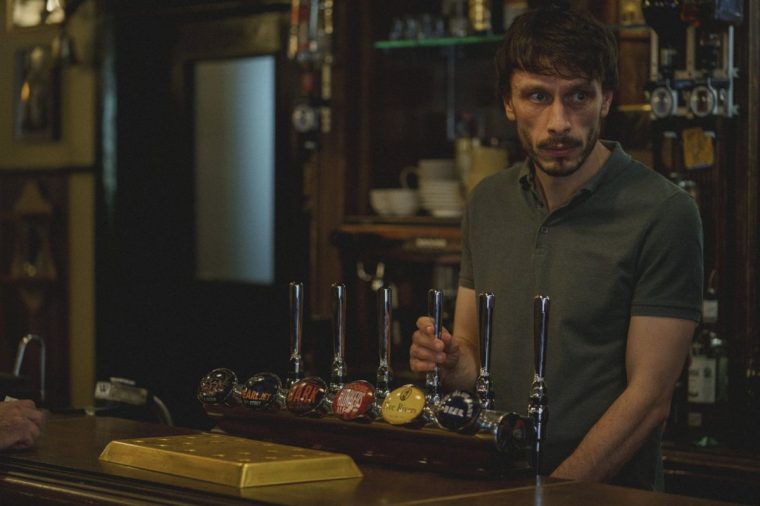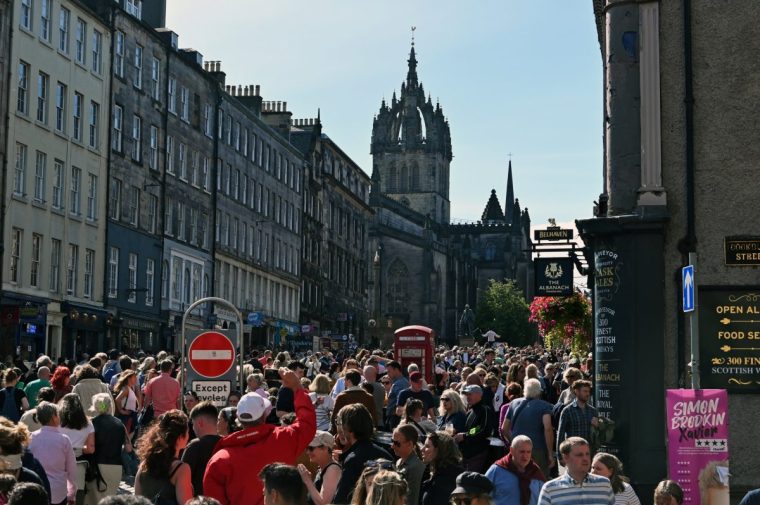The Edinburgh Festival Fringe is the largest performing arts festival in the world. From its humble origins in 1947, when eight troupes brazenly showed up to the inaugural Edinburgh International Festival that they were not invited to, and staged works on its fringes, it has evolved into a juggernaut (far bigger than the EIF, which continues to exist in parallel), running annually for the best part of August. In 2024, it registered 3,746 shows – the second largest in its history after 2019’s record 3,841 – and sold 2.6 million tickets.
Its promise of open access attracts artists from all around the world, from students taking their first steps on stage through to household names trying out new material. Many are lured by the knowledge it’s where world-famous names – from the theatre practitioner Steven Berkoff to comedians like Rowan Atkinson and the musical Six! – got their start. And the successes of Phoebe Waller-Bridge’s Fleabag and Richard Gadd’s Baby Reindeer, both of which also began life at the fringe, have added an extra layer to the narrative: it takes only a performer with a compelling story to snag a lucrative TV deal.
But the fringe is an unwieldy beast that takes over the entire city of Edinburgh for a month of the year. Locals with no intention of engaging with the festival – bus drivers, street cleaners, restaurant workers among them – must cater for the city’s swollen population every summer. And even those for whom it exists have a love-hate relationship with it. Creatives typically begin the month giddy with excitement before finding themselves exhausted and disappointed, performing to less-than-ideal audience numbers (according to official budgeting guidelines, selling 33 per cent of tickets is a success), with those empty seats converting into debt.
While the fringe is officially open to anyone, critics have long been raising concerns that it’s become a playground that only the relatively wealthy can afford to enter. Gone are the days of bringing up a show on a shoestring. The average cost of staging a one-person show has risen from £10,000 to £15,000 in just five years. Artists typically sink thousands of pounds of savings into a fringe stint – and the financial deficits when tickets don’t sell can be stomach-turning. What’s more, the inflated cost of accommodation – far more than venue hire – gets worse every year, with many private landlords using the fringe as an excuse to hike their prices.

In 2022, 1,600 creatives signed an open letter to the Edinburgh Festival Fringe Society criticising its failure to intervene and ensure affordable rooms for artists. And in her official letter reflecting on the 2024 fringe, outgoing Chief Executive Shona McCarthy even acknowledged that “an outward veneer of success cannot mask the struggle for artists to emerge, let alone thrive in the UK right now.” She went on to cite access to affordable accommodation and public sector cuts among the chief challenges.
The 2025 fringe, running from 1–25 August, may look a little different. It’s got a new CEO in Tony Lankester and a number of equally sparkly initiatives including, excitingly, a brand new venue, Shedinburgh, helmed by Fleabag and Baby Reindeer producer Francesca Moody, where a healthy mix of returning favourites and new work fizzing with potential will be shown.
The talent will undoubtedly be there in droves again too, but changes are needed to protect their welfare and prevent the whole thing running on sour backup fuel. So what could be done to make the whole experience more enjoyable for those emptying their pockets and pouring their energies into making it happen? Here are some practical solutions plus a little blue-sky thinking.
Greater wellbeing for artists
The fringe is a shock to the system for most artists who go from zero to 100, suddenly performing the show they’ve been developing for months – maybe even years – night after night. Coupled with the physical exhaustion (the term “fringe flu” was coined for a reason) is the stress of hoping their show is being well-received and the pressure to get good reviews – or any reviews, in a market where critics often swarm to the same billings, leaving the majority of listings undocumented.
In this exposing and competitive climate, artists need protection and support. It’s currently the luck of the draw whether your venue is one that offers hands-on help – many don’t. Meanwhile, artist check-ins and mindfulness sessions are often the initiative of the performers themselves. Since 2023, the Fringe Society has run a partnership with the mental health charity Health in Mind, which runs a support line for those who are struggling, but more preventative initiatives, like regular face-to-face meetups where creatives can share their concerns and air brewing grievances, could go a long way.
Fix the accommodation crisis once and for all
Edinburgh accommodation prices soared by as much as £1,225 a night ahead of the 2024 fringe. And the city’s hotels are predicted to be the most expensive in the world this summer – topping the likes of Dubai and Monaco. So profitable can a rental be that it’s not unusual for landlords to offer 11-month contracts instead of 12, turfing out their year-round tenants to make a small fortune in August.
Measures to counter this crookery are cursory at best, like the licensing scheme for short-term lets, which came into force in 2023 and ensures rentals meet basic safety standards, but the cost of which deters some from renting; and the Fringe’s new-for-2025 ‘host an artist’ drive, which is encouraging more locals to open up their homes to artists, while dissuading but not preventing them from overcharging.
In 2022, the festival’s eight leading venues issued a statement calling for all parties with a hand in the festival – including Edinburgh city council, the Fringe society, the EIF, Creative Scotland, the Arts Council, locals and visiting creatives – to work together towards a solution. Together, perhaps, they can fight back against rogue landlords.

More funding for the artists – and the fringe itself
While there are some bursaries available for a select number of artists, including the Keep it Fringe fund, which provides 180 shows with £2,500 each, the majority of artists must finance their fringe run themselves, setting up GoFundMe pages, applying for Arts Council funding or appealing to producers for support. This year, the Scottish government has provided the Fringe Society with an unprecedented cash injection of £300,000, much of which is earmarked for a “digital transformation strategy”, but should really be shared with artists.
And with 2,000 productions coming to the Scottish capital from England, the society understandably wants subsidising from the UK government too, including Theatre Tax Relief and a portion of Lisa Nandy’s £60m boost for creative industries. Similarly, once the Edinburgh tourist tax kicks in in 2026, generating an estimated £1m in Visitor Levy, the society is calling for the City of Edinburgh Council to ring-fence and redistribute that money into supporting the festival, which could eventually prove game-changing.
Normalise ‘Fringe Friend’ and ‘Love the Fringe’ memberships
A common complaint among artists is that audiences book tickets for one or two big-name acts, then spend the rest of their fringe jaunt hanging out at the surrounding pop-up bars. Should punters step up too? One way to do so would be to buy a Fringe Friend membership, which offers multiple tiers, all of which include two-for-one tickets and discounts, or the newer Love The Fringe membership scheme, which has five plans, the most basic of which costs £20 and entitles purchasers to three ‘free’ tickets to shows among several offers and discounts. Greater take up for these schemes could encourage viewers to see a larger quantity and variety of works, and venture beyond the Big Four venues to discover pockets of unsung brilliance.
Streamline awards – and ensure they’re meaningful
There is no shortage of awards at the fringe, but while these gongs certainly look great on show posters and press releases, they don’t carry equal weight. Some, like the long-standing Edinburgh Comedy Awards (which counts Harry Hill and Rose Matafeo among its successful recipients), offer a substantial prize of £10,000 for the winner and a further £5,000 for the best newcomer. Others are arguably tin pot accolades and little more than vanity projects for their awarding bodies.
Trophies and titles alone don’t secure a future life for a production. Streamlining and greater regulation of awards, ensuring they’re offering financial support, mentoring, another run or similar, would ensure all best-in-show shout outs are meaningful. Among those sorely missed are surely Les Enfants Terribles’ LET Award (last seen in 2023), with its cash injection, slot at prestigious venue group the Pleasance, mentorship and free press; and the British Council Showcase (last held in 2019), which helped secure international tours for its winners.
Better involvement and protection of locals and their businesses
Stray beyond the fringe-friendly venues plastered with show posters, and it’s not uncommon to hear locals grumbling about the festival. It’s understandable, what with commute times doubling, their favourite pub filled to the brim with tourists, and excitable performers thrusting flyers in their faces every time they brave the city centre.
Much more could be done to include local businesses and individuals who don’t have a direct link to the festival, from ensuring pop-up coffee stands aren’t competing with local cafés, to year-round outreach programmes, working in schools and community centres on storytelling projects, and platforming these hyper-local stories in some capacity during the festival to create a sense of involvement.
The theme, or tagline, of the fringe this year is “dare to discover”. But in these financially crippling times, few feel comfortable taking risks. Who wants to make a daring show when you can make a safer equivalent that puts more bums on seats? And if it’s a toss up between purchasing a ticket to an avant-garde show at an off-the-beaten-track venue you’ve heard nothing about, and a conventional one at a prestigious location that’s already received rave reviews, it takes a brave audience member to take a punt on the former.
But it shouldn’t. Attending the fringe in any capacity should be about celebrating – and, yes, discovering – art, from the pioneering to the change-making and the downright weird, and no one should be bankrupting themselves to do it.
